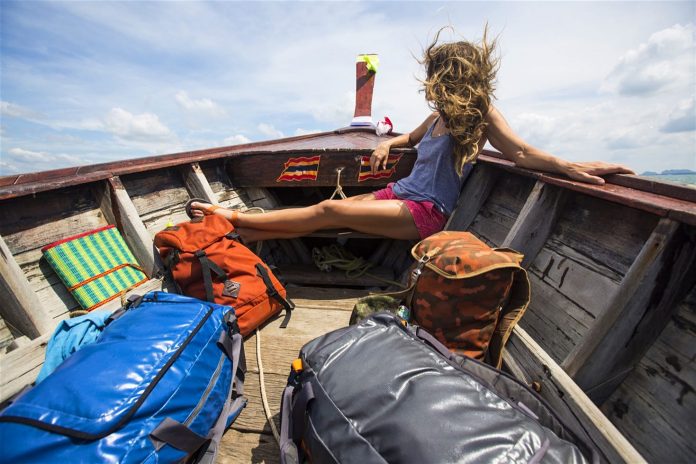Whether it’s spending hours pouring over airfare, sleeping in noisy hostels or battling through the red-eye squished in coach, traveling on a budget can feel like a hustle. Thankfully there are a handful of travel apps that can help save a few bucks on your dream trip – and help you plan for your next one. These are six of our favorite apps for budget travel.

Tripcoin
The best way to save on travel is to know where your money is going. Tripcoin is an expense-tracking app that works offline, which is great for international travelers who aren’t buying a local SIM card. A geo-location feature breaks expenses down by country, and a currency converter automatically converts new expenses into your home currency. Helpful graphs also outline daily expenditures, and you can create unlimited trips to track how much each jaunt costs.
 Skiplagged’s clever airfare loophole has drawn the ire of airlines © Image courtesy of Skiplagged
Skiplagged’s clever airfare loophole has drawn the ire of airlines © Image courtesy of Skiplagged
Skiplagged
Skiplagged capitalizes on a loophole airlines hate: hidden-city ticketing. It works like this: sometimes booking a flight beyond your intended destination is cheaper than simply booking a nonstop flight. For example, say you want to fly from San Francisco to Washington, DC. A regular round-trip ticket would cost $340, but a route from San Francisco to New York, with a layover in DC, is $140. You simply walk off the plane in DC. Airlines have gone to great lengths to put a stop to it (United sued Skiplagged in 2018, and lost). Skiplagged advises not tying any purchases to frequent flier accounts, as airlines have been known to invalidate air miles you’ve accrued with them.
Splitwise
If you’re traveling with friends, Splitwise can help keep track of who owes what to whom. The app keeps a running total of IOUs, so everyone gets paid back at once, rather in than a bunch of smaller transactions. Automatic email reminders keep the misers in check, and integration with PayPal and Venmo (US only) makes settling up friendly debts a breeze.

Hopper
There are several apps that analyze historical airfare data to determine whether it’s the right time to buy your airfare, but few of them are as cleanly presented and feature-packed as Hopper. Features like notifications when the airfare for a specific route drops, price prediction advice that gives you an idea when it’s the right time to buy, and an option for flexible dates give Hopper a leg up on airfare deals. Put in your home city and destination and Hopper displays a calendar for the year ahead, with color-coded dates indicating when prices should be at their lowest.
HotelTonight
HotelTonight allows travelers to arrange last-minute accommodations, often at prices lower than if they’d booked in advance. These last-minute reservations often have deep discounts so hotels can increase occupancy on rooms they weren’t able to book in advance. A ‘Daily Deal’ feature also unlocks a reduced-priced hotel that must be booked within 15 minutes. If you don’t mind waiting until the day before or day of to book your hotel, this app can save bundles on accommodation.

AirHelp
Lost luggage and delayed or canceled flights can be a costly experience, but many travelers are eligible for compensation when something goes wrong. Often, however, there are dozens of hoops to jump through – forms to fill out, phone numbers to call and lines to wait in. AirHelp takes care of most of the process: you add your trip details, AirHelp determines if the airline owes you money, and then they send you the money. The catch: AirHelp takes a cut of the compensation as the price for convenience.
Talking about manners on planes always makes me feel like a doddering inhabitant of Downton Abbey, gasping sniffily about how standards are slipping to my equally doddering friends. But let’s be real: these days flying is more akin to a local bus than a transatlantic voyage on the Queen Elizabeth 2, so comparing some notional golden age of travel when flying was only for the super rich is unfair. There are, however, still a few ways in which flying would be better if we could all just be a little more thoughtful, a little more mindful of flying etiquette, and realize how our own behaviour affects others when travelling.

Bags: know what you’re allowed and don’t be a binhog
Marshalling carry-on bags is a colossal headache for everyone, and airlines don’t help since it feels like every single one has a different policy. So read the ticket rules carefully, and make sure you know what you’re allowed to bring.
If you’re allowed just a ‘small personal item,’ don’t try and chance it on the size, especially on low-cost airlines where the infamous bag sizer comes out.

If you get a bag plus a personal item, then your bag should go overhead and your personal item should go underneath the seat in front of you. (Not, for the love of Howard Hughes, underneath your neighbour’s seat.) Don’t take up all the bin space with your coat either.
If you’re in the aisle or window seat, perhaps don’t get all your stuff out during boarding until anyone who might need to get past you has boarded. Consider using the time you’re waiting to board on the jetway to have your reading material, phone charger or whatever else you might need handy so you’re not blocking the aisles.
And consider whether it might be easier – and better flying etiquette – to check a bag. Yes, I’m one of those weird frequent travellers who often checks a piece of luggage: since I travel so much internationally rather than domestically I rarely find that I have much of a wait after immigration and customs, and I just can’t abide either the plastic waste of buying little bottles of all my toiletries or decanting them from bigger bottles before I leave.
Armrests: there’s one simple rule
In economy, the middle seat passenger gets both armrests. Thank you for coming to my TED Talk.
Aisle passengers, though, be aware: your aisle-side armrest may well slide up by pressing a switch or flipping a catch that’s hidden somewhere near the mechanism. This not only gives you a bit of extra wiggle room, it lets you rotate at the waist to let the middle and/or window seat passenger slip past without having to get up into the aisle.
Feet: keep them secret, keep them safe
Nobody, repeat nobody, wants to see your toes up close. If you must take your shoes off on a longer flight, keep your socks on and ideally bring a fresh pair as a courtesy to everyone around you. Bear in mind also that you can cause offense in many cultures by pointing your feet or showing parts of them, so just keep ‘em socked and on the floor. (And oh my, not on the bulkhead wall like some sort of animal cocking its leg.)

And keep them to yourself! This is especially important for those of us flying in economy class. I’ve lost track of the number of appalled faces I’ve seen online where travellers discover an errant foot snaking, unsocked, behind their seat to rest on the rear of their armrest.
Look, planes are pretty gross, germwise, and the floors are the worst. If you must come in open-toed shoes, whether it’s resort-wear sandals or a fun little wedge for the weekend, please keep them on: it’s not just that your feet are gross, it’s that they’ve probably picked up some additional horror from the floors. And perhaps consider whether a light athleisure combo shoe — terrible name, great idea — might suit your travels better than that gladiator sandal.
Clothes: let’s be realistic
It’s 2019, and it’s unreasonable to expect a three-piece suit or a formal two-piece in wrinkle-resistent Crimplene from the days of chateaubriand-and-caviar flying in today’s peanuts-if-you’re-lucky.
Leggings are pants, shorts are fine in summer, and nobody should be fainting over the shocking sight of an uncovered shoulder. (Qantas is still likely to say you can’t come in the lounge wearing the footwear variously known as flipflops, thongs or jandals, though, and I can’t recommend wearing these to fly for reasons of safety and hygiene.)
That said, let’s try to be as courteous to other passengers as we would like them to be towards us. Perhaps choose a short that goes all the way down the thigh to avoid spending several hours with the side of your bare leg pressed up against that of your closest neighbour. Let’s travel in our second-nicest pair of shorts rather than our second-rattiest. But, in general, let’s just keep our own thoughts about other people’s bodies to ourselves, shall we?




